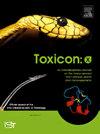Evolutionary insights into toxins diversity in Ceriantharia (Cnidaria; Anthozoa)
IF 2.8
Q2 TOXICOLOGY
引用次数: 0
Abstract
Ceriantharians synthesize and inoculate the toxins found in their stinging cells spread throughout the body. For most cnidarians the putative toxins profile can vary widely depending on the tissue function and the environmental conditions faced by these marine invertebrates. Extensive gene duplications events have impacted the diversity of the toxins system of cnidarians and could explain the rapid emergence of novel toxins. On the other hand, it seems for Ceriantharia, the putative toxins profile does not exhibit major variation, despite occupying different ecological niches. Some species of ceriantharians have a planktonic stage that is highly dispersive, while the benthic phase is characterized by semi-sessile polyp. However, the polyp builds a tube involving the entire column that can play an additional function by protecting against predators and competitors, which could decrease the need to synthesize a wide array of toxins. In the present study, we compare the putative toxins of the larva and polyp of Arachnanthus errans based on the functional annotations of the transcriptomes against annotated protein databases. We seek to understand the evolutionary process of two toxin-like protein families using phylogenetic reconstruction methods with target sequences of the transcriptome of nine ceriantharian species. Our exploration revealed that the larva expresses 70 more toxin-like genes than the polyp, which may relate to abiotic and biotic factors the larva experiences. Our phylogenetic analyses suggest duplication events may have occurred in both toxins-like proteins and the two copies of Kunitz-like proteins might have been present in the common ancestor of Ceriantharia.

Ceriantharia (Cnidaria)毒素多样性的进化研究珊瑚虫的)
在刺刺细胞中发现的毒素会扩散到全身,这种动物会合成并接种毒素。对于大多数刺胞动物来说,根据这些海洋无脊椎动物所面临的组织功能和环境条件,推测的毒素分布可能会有很大差异。广泛的基因复制事件影响了刺胞动物毒素系统的多样性,可以解释新毒素的快速出现。另一方面,对于Ceriantharia,尽管占据不同的生态位,假定的毒素谱似乎没有表现出大的变化。某些种类的鲸类动物有一个高度分散的浮游阶段,而底栖阶段的特征是半无根的水螅体。然而,珊瑚虫会形成一个包含整个柱体的管状结构,它可以发挥额外的功能,保护自己免受捕食者和竞争对手的侵害,这可以减少合成各种毒素的需要。在本研究中,我们基于转录组与注释蛋白数据库的功能注释,比较了Arachnanthus errans幼虫和息肉的推定毒素。我们试图了解两个毒素样蛋白家族的进化过程,使用系统发育重建方法与目标序列的转录组九种天牛。我们的研究发现,幼虫比息肉多表达70个毒素样基因,这可能与幼虫经历的非生物和生物因素有关。我们的系统发育分析表明,这两种毒素样蛋白可能都发生了复制事件,而这两种库尼茨样蛋白可能存在于Ceriantharia的共同祖先中。
本文章由计算机程序翻译,如有差异,请以英文原文为准。
求助全文
约1分钟内获得全文
求助全文
来源期刊

Toxicon: X
Pharmacology, Toxicology and Pharmaceutics-Toxicology
CiteScore
6.50
自引率
0.00%
发文量
33
审稿时长
14 weeks
 求助内容:
求助内容: 应助结果提醒方式:
应助结果提醒方式:


